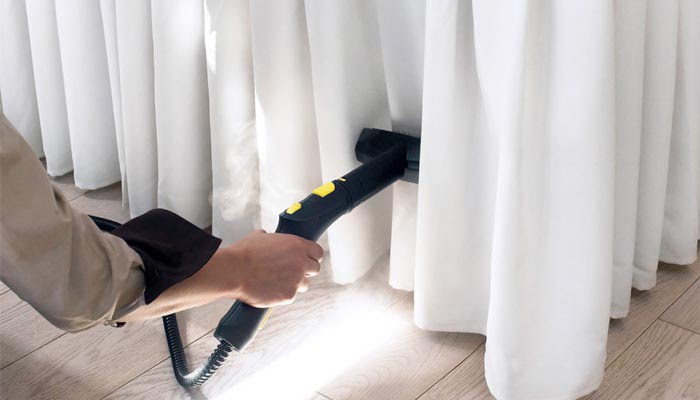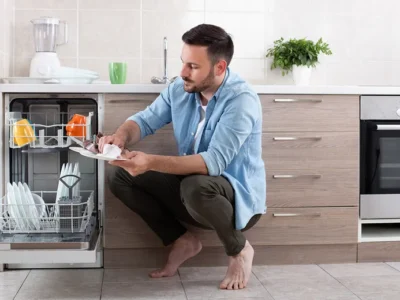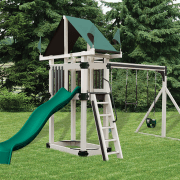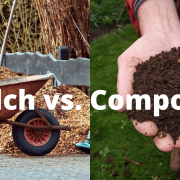Experts consider window treatments vital for interior design. In fact, many of them think curtains and drapes are worth the investment. This isn’t surprising considering that these pieces not only make a space look more beautiful but also provide other practical benefits, such as:
- Enhanced privacy
- Climate control
- Insulation
- Noise reduction
- Security
Of course, you can only get valuable returns on your investment if you put enough time and effort into taking care of them.
With that in mind, here is an eight-step guide to cleaning your high-end fabric curtains:
Step #1: Remove the window treatments.
Detach the curtain rods and hardware to free the window treatments you wish to clean. Make sure you use a sturdy ladder or stepping stool held in place by another person.
Once the curtains are loose, carefully lay them out on a table, hardwood floors, kitchen island, or any flat surface.
Bonus Tip: Take this opportunity to clean the areas usually covered by curtain rods and hardware to maximize your time and effort.
Step #2: Perform a colorfastness test.
Many curtains are machine or hand-washable, but that doesn’t mean you should just throw them into the washing machine with other fabrics. To be safe, you must check the colorfastness of the material they’re made from.
Colorfastness is the fabric’s ability to resist changes in its color. It also determines whether the colorants used to dye it can transfer to adjacent materials.
You can perform a colorfastness test for all sorts of fabric pieces, including curtains and clothes. The result tells you whether you can wash different-colored pieces together in the laundry.
Follow these steps to check whether your window treatments retain their beauty even after several washes:
- Choose a hidden part of the curtain to test.
- Wet the sample area with warm water and detergent. Leave it for a couple of minutes.
- Press a white cloth onto the wet area to see whether the color of the curtain transfers onto the light fabric.
If the sample area goes through any noticeable changes or the white cloth catches the color of the curtain, then the piece you’re testing is not colorfast. When this happens, it would be better to bring your window treatment to an expert for professional curtain cleaning.
Step #3: Prepare everything you need.
After confirming that you can clean the curtains yourself, the next step is to prepare the necessary tools, equipment, and products you’ll need to wash them. This way, you’ll have everything ready without having to stop what you’re doing to buy the stuff you don’t have.
For the equipment and tools, you’ll need the following:
- Vacuum with a dust brush or upholstery brush attachment
- Washing machine
- Iron
- Pressing cloth or handheld steamer
For cleaning products, a mild laundry detergent for hand or machine washing should suffice.
Step #4: Vacuum the fabric.
Many experts recommend vacuuming curtains before washing to eliminate excess dust and debris.
To get the best results, use your vacuum cleaner’s dust or upholstery brush attachment and reduce the suction power to the lowest possible setting.
If your equipment doesn’t have a lower setting, you can also cover the attachment hose with a nylon sock to decrease the suction power.
Important Note: Some curtain materials don’t work well with vacuum cleaners. Sheer and delicate fabrics should not undergo this step, as they may get caught in the vacuum cleaner. Instead, take them outside and shake the dust off before moving on to the next step.
Step #5: Pre-treat significant stains.
Some curtains may show dirt spots and stains from fingers touching the fabric. If this is the case (and your window treatments are made from cotton), you can perform spot cleaning and pre-treatment on the stains before washing them.
Step #6: Follow the recommended fabric cleaning method.
Since drapes and curtains are made from different types of fabric, the safest option is to wash them based on the manufacturer’s instructions. If they no longer have tags, you can opt to dry-clean them instead.
But like most rules, this comes with a few exceptions.
Read on to learn which fabric materials should and should not be washed.
Linen
Linen drapes should be dry-cleaned only to avoid damage from the washing.
Cotton
Unless they have fragile liners, cotton drapes are machine washable.
Silk
Silk is a sensitive fabric that requires gentle hand washing with lukewarm or cool water and mild soap.
You can also hang silk curtains to dry, though you must be careful not to twist them forcibly lest you risk wrinkling them.
Sheer
Sheer curtains may discolor from infrequent cleaning, but most cannot withstand machine washing. Instead, you must soak them in cold water before hand-washing.
Some sheer curtains can be laundered in a machine if the wash setting is in a gentle cycle and the dryer doesn’t give off heat. Experts also recommend putting them in the dryer with soft terry cloth towels to soften the material.
Synthetic
Curtains made from polyester, acrylic, and other synthetic fabrics should never be dry-cleaned because the solvents used for the process may degrade the fibers of the material. If your curtains are made from this type of material, stick to hand- and machine-washing.
Wool or Cashmere
There aren’t many drapes made from wool and cashmere. But if your window treatments contain a pure or mixed blend of these fabrics, you best leave them with dry-cleaning experts.
Velvet
Any velvet or velvet-blended drapery should be brushed, not washed. Using a chamois cloth dampened with hot water, gently wipe off dust bunnies on your velvet drapes.
Step #7: Air-dry or machine-dry on low heat.
After washing, you can air-dry your window treatments by hanging them outside.
You can also use a machine dryer for this, but make sure you change the setting to low heat. Once they’re roughly 95 percent dry, take the curtains out of the dryer. This will prevent any wrinkles from setting in.
Step #8: Iron out any remaining wrinkles.
For best results, iron out the wrinkles on your slightly damp curtains. This is best done on the flip side of pieces made from cotton fabric.
You can also use a handheld steamer or a pressing cloth with regular iron to prevent scorching.
Take care of your drapes
Curtains and drapery don’t come cheap. They represent a significant investment that offers valuable returns when properly cared for.
Follow this helpful guide to clean them properly and take full advantage of the benefits your window treatments can provide.














Comments